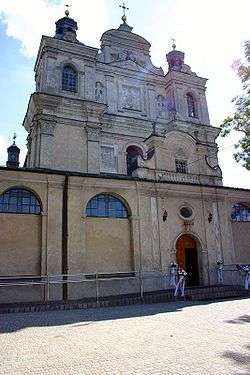Opole Lubelskie
| Opole Lubelskie | ||
|---|---|---|
|
Church in Opole Lubelskie | ||
| ||
 Opole Lubelskie | ||
| Coordinates: 51°9′N 21°58′E / 51.150°N 21.967°E | ||
| Country |
| |
| Voivodeship | Lublin | |
| County | Opole Lubelskie County | |
| Gmina | Gmina Opole Lubelskie | |
| Government | ||
| • Mayor | Dariusz Wróbel | |
| Area | ||
| • Total | 15.12 km2 (5.84 sq mi) | |
| Population (2006) | ||
| • Total | 8,832 | |
| • Density | 580/km2 (1,500/sq mi) | |
| Time zone | CET (UTC+1) | |
| • Summer (DST) | CEST (UTC+2) | |
| Postal code | 24-300 | |
| Car plates | LOP | |
| Website | http://www.opolelubelskie.pl/ | |
Opole Lubelskie [ɔˈpɔlɛ luˈbɛlskʲɛ] is a town in eastern Poland. As of 2004, it had 8,879 inhabitants. The town is situated in Lublin Voivodeship, some 10 kilometers east of the Vistula River, and is the capital of Opole Lubelskie County. It was founded in the 14th century, and historically belongs to Lublin Land, which is part of Lesser Poland.
Etymology
The word "opole" comes from a Slavic language root, and designates a basic unit of Slavic tribal territory. Tribal organization, based on the opole, remained operative in Poland until the Middle Ages. There are several places named Opole in Poland, the best known being in Upper Silesia. To distinguish between these two, the adjective "Lubelskie" was added to the name of the town that is located near the city of Lublin.
History
First wooden church in Opole Lubelskie was probably built in the 12th century. In 1368, by decree of Casimir III the Great, Opole received Magdeburg rights, which was confirmed in documents issued in 1419. In the 16th and 17th centuries, Opole Lubelskie was one of centers of Reformation. Several Calvinists were active here. In 1625, a hospital was built outside the town, along the road to Sandomierz. Between 1663 and 1675, a new parish church was constructed, which still stands. In the mid 18th century, Opole Lubelskie prospered, after Piarists came here upon request of Jan Tarło, who also rebuilt the Slupezcki Palace (now Lubomirski Palace) in the baroque style.
A new hospital and schools were built, the church was expanded and a monastery was opened. In the late 18th century, Rozalia Lubomirska spent a few years in the palace of her husband Aleksander, located in the village of Niezdów, near Opole Lubelskie.
The town had a significant Jewish minority, which perished during the Holocaust. The Opole Lubelskie Ghetto was created in March 1941, with Jews both from the town, and from such locations, as Kazimierz Dolny and Puławy. Later on, Jews from Austria, France and Slovakia were brought here. The ghetto was liquidated in October 1942, when its 9,000 inhabitants were transported to Sobibor extermination camp.
The town is home to one of the most modern prison in Poland - Zakład Karny Opole Lubelskie, which was opened in October 2009. Among points of interest there are parish Church of Saint Mary (1663-1675, expanded 1748), complex of Piarist Monastery, Lubomirski Palace (today it houses a high school), town hall (1750), tenement houses, cemetery chapel (1790). The cemetery itself was opened in 1772.
See also
- UFO-memorial Emilcin at the village Emilcin, belonging to Opole Lubelskie.
Coordinates: 51°09′N 21°58′E / 51.150°N 21.967°E


